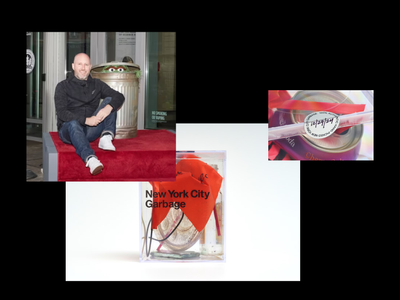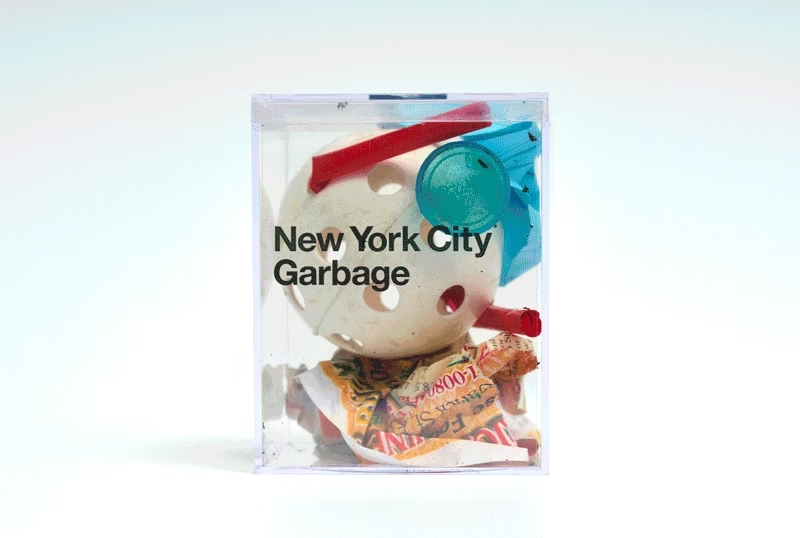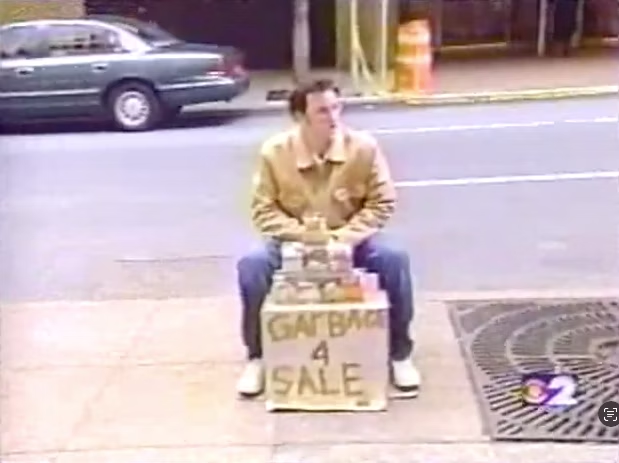The $100 garbage cube that sold out in two hours
A designer turned New York City trash into coveted collectibles, proving that value is less about what you sell than how you sell it.
ByRELEASE DETAILS
Creator: Justin Gignac
Release: NYC Garbage Season 2
Format: Limited edition sculptures (50 pieces)
Price: $100 each
Status: Sold out in 2 hours
THE STORY
What began as a cheeky argument about package design in 2001 became an unlikely lesson in perceived value. Justin Gignac started selling cubes of NYC street trash to prove that anything could be desirable with the right presentation. Twenty years later, he brought the project to Metalabel with a sophisticated understanding of scarcity and storytelling.
The release strategy was deceptively simple: build anticipation through a waitlist that shared a playful GIF of NYC's most iconic queues. Within a week, 117 people joined - more than double the available editions. The cubes sold out in two hours, with collectors split between New Yorkers wanting a piece of their city and far-flung admirers seeking connection to a place they'd never been.
"When it was $10 people thought it was a funny joke, when it was $25 people thought it was a cool souvenir, and when it was $50 people started calling it art," Gignac notes. The $100 price point for this release completed the transformation from novelty to collectible.
KEY INSIGHTS
Being "not for everybody" accelerates community formation. The polarizing nature of selling garbage helped define and energize its audience.
Price shapes perception. Each price tier ($10, $25, $50, $100) transformed how people viewed the exact same object.
Simple storytelling beats complex marketing. The core narrative never changed: "Your city's garbage sucks compared to ours."
Build natural documentation into the release. In post-sale outreach Gignac saw enthusiasm when asking collectors to photograph where their garbage lives now.
IN THE CREATOR'S WORDS
"The art isn't in the cube. I've made it more artistic and visually appealing to make it as collectible as possible, but the art is in the transaction. For me, convincing someone to buy garbage is the artwork." Read the full interview below.
HOW TO MAKE YOUR RELEASE MATTER: LESSONS FROM SELLING LITERAL GARBAGE BY JUSTIN GIGNAC
New York City Garbage began in 2001. Did you feel like you were creating a community around it when you did your initial releases?
JUSTIN GIGNAC: It happened very quickly, which was surprising since the idea is very polarizing. We're in an artsy-fartsy circle where a lot of people will get it, but most people don't get it, which I love. I like that it's not for everybody. Community forges quickly when people feel like they're a part of something.
When I first started selling, I was selling it on the streets and I didn't get anyone to buy it for the first eight hours. An older man came by and bought one for five bucks, so the next day I came out with newfound confidence and was on the street saying ”wherever you're from, your garbage sucks compared to ours.” That next set I sold four or five more, I made the website, and sent it to some press. It got picked up in Time Out New York, then NBC News and CBS News were in my dorm room, and I was doing radio show interviews in the middle of my filming of the CBS interview on TV. All of it started happening so quickly. Later Metro New York newspaper would pick it up, the London edition a week later, and then suddenly I started getting press requests from Ireland, Scotland, Korea, Japan, and various other parts of Europe. I saw the spider web effect of virality before the early internet and before social media.
The community excited about NYC Garbage are two different groups of people. One is people who live in New York currently or are expats who just love the city. It's such a character in our city; an actual piece of the day-to-day lives of New Yorkers. Then there are the people who've never been to New York, maybe only seen it in TV and movies, and have this love and affinity for a city they have never been to, but they still want a part of.
Are there other ways you are in touch with people, or do you rely on press & word of mouth networks?
It was really all word of mouth. I had a mailing list for a while, but then I lost it. After I stopped selling in 2012, I built a starter waiting list that grew to 830 people on it. This time around I was able to re-engage those folks and send them emails to say, “Hey, I'm starting this up again.” Using social media, the waitlist collectors on Metalabel, and then having that old mailing list were my main outlets.
From the start, though, I’ve focused on opening the line of communication with new people who buy NYC Garbage, saying, “Hey, here's where your thing is. Now I'd love to see where it ends up” and encourage them to create content, tag me, or make unboxing videos which could be really fun.
I’ve asked collectors to send me pictures of where their garbage lives now, in their new adoptive homes—Australia, Sweden, Ethiopia, Duomo di Milano, Rome—and put them on my website. This time around I'm using a postcard to encourage people to send me pictures, and I'm going to tell them what neighborhood the garbage is picked from, which I've never done before.
What made you return to the project after such a long time?
I started my own company Working Not Working — a website to help creative people get work — about 13 years ago, which is when I stopped doing NYC Garbage. Over the years, people have asked “when are you going to make garbage again?” or “I never got one of those cubes!” It kept coming up again and again. Last time I did it, social media didn't exist. I had to build a following through blogs and free newspapers. I got curious about what could happen now. Also, I've been wanting to get back into making art. This project felt like a good way for me to get back into making and to give me the space to figure out what else I want to make.
Are you thinking about NYC Garbage differently now than when you were before?
I started NYC Garbage because some friends and I were having a debate about the importance of package design. Someone said package design didn't matter. And I thought that was ridiculous. So I tried to package something nobody would ever want to buy.
For me, the art wasn't in the cube. I've made it more artistic and visually appealing to make it as collectible as possible, but the art is in the transaction. For me, convincing someone to buy garbage is the artwork.
When I first started, Beanie Babies were really popular which I thought was the most ridiculous shit ever. But I thought “what can I learn from this? limited editions.” so then I decided to number every one, sign it, and put a date on it. The new design of the packaging is cleaner and I have this silver sticker on the top, as opposed to a shitty little white paper sticker. All these things were to check some boxes of collectibility and go over the top with it.
Everything I learned about advertising, I learned by selling garbage. There are just so many insights. For example, when I initially sold it on the website, they were $9.99 a piece. I couldn't keep up the demand, so I raised the price to $25 after a year, and they still sold just as much. Two years later, I couldn't keep up the demand, so I doubled the price to $50 and they still sold just as much. When it was $10 people thought it was like a funny joke, when it was $25 people thought it was a cool souvenir, and when it was $50 people started calling it art. It's really amazing when you change people's perception of value. That’s what the entire luxury goods industry is: “I'm telling you, this is worth more.”
Now, I'm looking into more new formats like limited editions for special events. For example, I got flown to Dublin, Ireland to do the St Patrick's Day parade to make 100 cubes and got to sit two rows in front of the Irish president and three rows in front of the prime minister. It made me think: can I go and get flown to the Super Bowl and the Formula One races? It would be a really cool way to see the world. What else can I do to push the format?
What gives you confidence to try these different iterations?
If I make 100 more and they don't sell, I'll just give them to friends. It's not that big of a deal because it's fun to experiment. Now, I'm thinking about collaborations with some NY-centric influencers, holographic trading cards, and stuff like that. How do we have fun with this medium? Can we do different New York stories? Ones based around music? around art? What if different artists let me into their studios and get garbage from their studios? I did backstage at New York Fashion Week once and those cubes look very different. Who works at the Department of Sanitation? Let's figure it out. Where can I get access, and what can I make out of it?
Eventually the goal is to have a big gallery show of a map of every NYC neighborhood with cubes from each neighborhood and a life size inflatable garbage truck to bring a lot of celebration around the garbage. Like a face only a mother can love, we New Yorkers love our trash. Still, I'm very discerning with my trash—I go on the sidewalks and streets, I don't pick up anything gross, or anything that's too smelly—I make sure I'm getting quality garbage.
Anything else you've learned or are embedded into what’s next?
1. Have fun with it. I had friends and acquaintances from my career message me and say “can you just bottle the joy that was in that video [about selling out of your Metalabel release]?” Every creative person wants that feeling of “Hey, I just put something out of the world. And people were really into it. This is awesome.”
In 2018 I went to Australia to speak at a conference, and during the happy hour a guy jumped up on the table and is, like “this guy's being modest” and told them my resume of things that I've done. And people were like, “Oh my God, you're the one who sold garbage?!” I'm like, “Wait, you guys have heard of that? Holy shit. This is crazy.” It’s amazing to see that this project inspired people throughout the years and is giving people confidence to do their own side projects.
2. If I can sell garbage, you can sell anything. It really is about just doing it. I came up with the idea in the summer of 2000, but I procrastinated like a mofo and just kept telling my friends about it until eventually they said “you told us, when the fuck you gonna do it?” When I finally went and made 10 cubes I needed that motivation, but then once I did it, it was this “oh” feeling. After that point, at every job I got in advertising as an art director and creative director people specifically told me they hired me because I sold garbage. The sentiment was "your book is good, and we know you can do it, but the fact that you took the initiative to go out and make [NYC Garbage] and made it wildly popular is so much more interesting.”
My first website for Garbage was made with a Photoshop program called Image Ready that sliced up your photoshop file and turned it into a website that would take 10 seconds to load. Now, I can make a Tumblr, a Squarespace, a Metalabel page in a weekend: come up with an idea on Friday, make it over the weekend, launch it on Monday, and have it go viral by Wednesday. The internet is magic. It's so easy now, no excuses.


